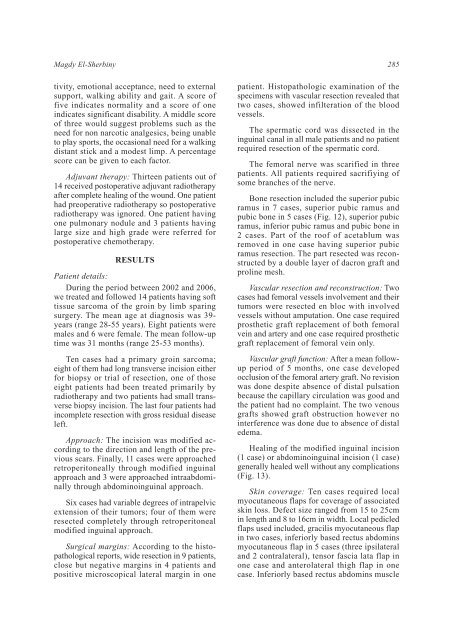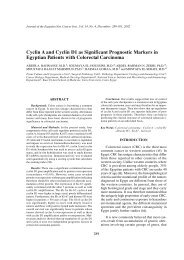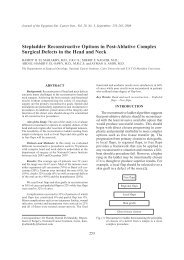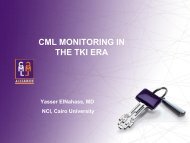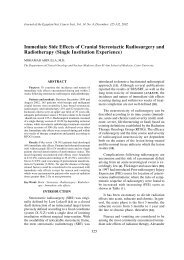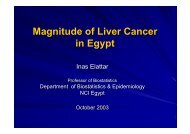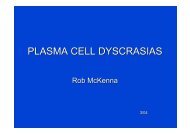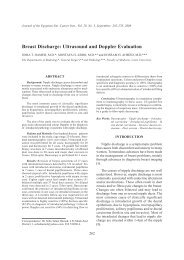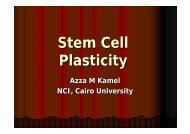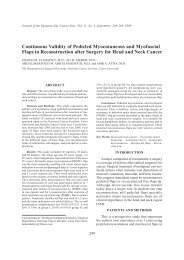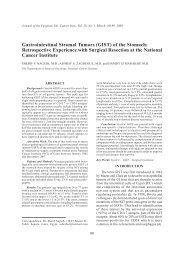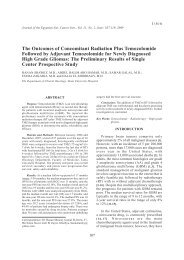Limb Sparing Surgical Resection of Groin Sarcoma. Surgical ... - NCI
Limb Sparing Surgical Resection of Groin Sarcoma. Surgical ... - NCI
Limb Sparing Surgical Resection of Groin Sarcoma. Surgical ... - NCI
Create successful ePaper yourself
Turn your PDF publications into a flip-book with our unique Google optimized e-Paper software.
Magdy El-Sherbiny 285tivity, emotional acceptance, need to externalsupport, walking ability and gait. A score <strong>of</strong>five indicates normality and a score <strong>of</strong> oneindicates significant disability. A middle score<strong>of</strong> three would suggest problems such as theneed for non narcotic analgesics, being unableto play sports, the occasional need for a walkingdistant stick and a modest limp. A percentagescore can be given to each factor.Adjuvant therapy: Thirteen patients out <strong>of</strong>14 received postoperative adjuvant radiotherapyafter complete healing <strong>of</strong> the wound. One patienthad preoperative radiotherapy so postoperativeradiotherapy was ignored. One patient havingone pulmonary nodule and 3 patients havinglarge size and high grade were referred forpostoperative chemotherapy.RESULTSPatient details:During the period between 2002 and 2006,we treated and followed 14 patients having s<strong>of</strong>ttissue sarcoma <strong>of</strong> the groin by limb sparingsurgery. The mean age at diagnosis was 39-years (range 28-55 years). Eight patients weremales and 6 were female. The mean follow-uptime was 31 months (range 25-53 months).Ten cases had a primary groin sarcoma;eight <strong>of</strong> them had long transverse incision eitherfor biopsy or trial <strong>of</strong> resection, one <strong>of</strong> thoseeight patients had been treated primarily byradiotherapy and two patients had small transversebiopsy incision. The last four patients hadincomplete resection with gross residual diseaseleft.Approach: The incision was modified accordingto the direction and length <strong>of</strong> the previousscars. Finally, 11 cases were approachedretroperitoneally through modified inguinalapproach and 3 were approached intraabdominallythrough abdominoinguinal approach.Six cases had variable degrees <strong>of</strong> intrapelvicextension <strong>of</strong> their tumors; four <strong>of</strong> them wereresected completely through retroperitonealmodified inguinal approach.<strong>Surgical</strong> margins: According to the histopathologicalreports, wide resection in 9 patients,close but negative margins in 4 patients andpositive microscopical lateral margin in onepatient. Histopathologic examination <strong>of</strong> thespecimens with vascular resection revealed thattwo cases, showed infilteration <strong>of</strong> the bloodvessels.The spermatic cord was dissected in theinguinal canal in all male patients and no patientrequired resection <strong>of</strong> the spermatic cord.The femoral nerve was scarified in threepatients. All patients required sacrifiying <strong>of</strong>some branches <strong>of</strong> the nerve.Bone resection included the superior pubicramus in 7 cases, superior pubic ramus andpubic bone in 5 cases (Fig. 12), superior pubicramus, inferior pubic ramus and pubic bone in2 cases. Part <strong>of</strong> the ro<strong>of</strong> <strong>of</strong> acetablum wasremoved in one case having superior pubicramus resection. The part resected was reconstructedby a double layer <strong>of</strong> dacron graft andproline mesh.Vascular resection and reconstruction: Twocases had femoral vessels involvement and theirtumors were resected en bloc with involvedvessels without amputation. One case requiredprosthetic graft replacement <strong>of</strong> both femoralvein and artery and one case required prostheticgraft replacement <strong>of</strong> femoral vein only.Vascular graft function: After a mean followupperiod <strong>of</strong> 5 months, one case developedocclusion <strong>of</strong> the femoral artery graft. No revisionwas done despite absence <strong>of</strong> distal pulsationbecause the capillary circulation was good andthe patient had no complaint. The two venousgrafts showed graft obstruction however nointerference was done due to absence <strong>of</strong> distaledema.Healing <strong>of</strong> the modified inguinal incision(1 case) or abdominoinguinal incision (1 case)generally healed well without any complications(Fig. 13).Skin coverage: Ten cases required localmyocutaneous flaps for coverage <strong>of</strong> associatedskin loss. Defect size ranged from 15 to 25cmin length and 8 to 16cm in width. Local pedicledflaps used included, gracilis myocutaneous flapin two cases, inferiorly based rectus abdominsmyocutaneous flap in 5 cases (three ipsilateraland 2 contralateral), tensor fascia lata flap inone case and anterolateral thigh flap in onecase. Inferiorly based rectus abdomins muscle


